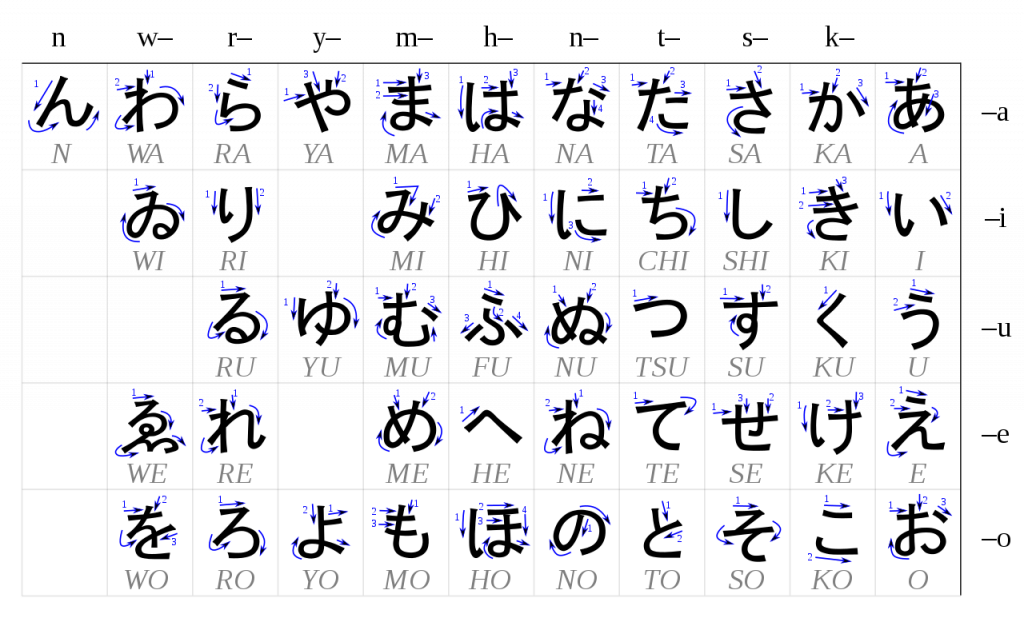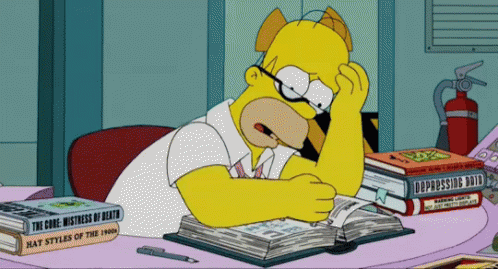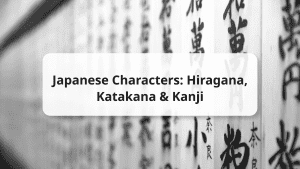The Japanese alphabet, more commonly known as Japanese characters or kana, are three writing systems that work together to create all Japanese sentences. There are two syllabic and phonetic character systems; hiragana (平仮名) and katakana (片仮名) while the kanji (漢字) consists of ideograms that correspond to a certain meaning, adopted from Chinese characters.
Yes, there really are three! But each system has different purposes and characteristics that are equally important in Japanese writing. Make sure to check out our article on how to learn Japanese to have a more in-depth idea about learning Japanese or how to say hello, thank you or sorry in Japanese.
Table of Contents
ToggleThree Writing Systems: Japanese Characters
Perhaps you’ve already traveled to Japan and noticed that the signs have some curvy letters, some blocky letters, and some very complicated characters. These are the three writing systems for the Japanese Alphabet and they work together and can be used in unison to form modern-day Japanese sentences. Let’s go over each one individually.
Japanese Characters: Hiragana & Hiragana Chart
Women rock! Why you may ask? Because historically, only men were able to study Kanji so Hiragana (平仮名) was created by women as an alternative. Over time, because Hiragana was based on phonetics rather than the ideograms of Kanji, it started to be used in all Japanese people’s writing. To read the full Hiragana chart, start with the top sounds and then the right-hand side. Combine them together and you get the associated hiragana alphabet. This chart also shows the stroke order to help you understand how to write these characters correctly.

Now, Hiragana is often known as the writing system for native Japanese words. There are 46 kana, each representing one unique Japanese syllable. Learning and mastering Hiragana is the most important step in a beginner’s journey in writing and reading Japanese
You will also notice that sometimes, written above Kanji, there is Hiragana. This is called furigana (ふりがな) to help readers who may not know the Kanji’s pronunciation. Another reason why learning Hiragana first is crucial.

Japanese Characters: Katakana & Katakana Chart
Next, we have Katakana (片仮名). It is known mainly for its use in foreign words, names, and loan words within the Japanese alphabet. Like Hiragana, there are 46 kana or sounds that are used. For beginners, these are the main usages. As you progress into intermediate, Japanese speakers will use Katakana for onomatopeia and even just to highlight certain words. Same with the Hiragana chart, the Katakana chart is read starting at the top then, on the right. This chart also shows the stroke order to help you understand how to write these characters correctly.

When first learning Japanese, any foreign name can be directly translated using Katakana. For example, the name Katie would be written like “ケーティ” or Ethan like “イーサン”. Try converting your name here!
Loanwords are commonly written using Katakana as well (except the ones of Chinese origin). While these words are made to sound like the original word, the end result is quite different from the original pronunciation. This is because Japanese syllables and pronunciation rules are used.
Lates take a look at some examples:
Microphone: Maiku (マイク)
Bargain: Bāgen (バーゲン)
Hotel: Hoteru (ホテル)
Don’t Mind/No Worries: Donmai (ドンマイ)
Japanese Characters: Kanji
Finally, we should understand Kanji (漢字). Originally, these ideograms (also known as characters) first came to Japan in the fifth century. They were on things like official seals, letters, and other imported goods from China. During that time, Japan had its own spoken and native language but no writing to follow it. Over time, the Japanese people used Chinese characters for spoken Japanese, matching up characters to Japanese meanings. They did, however, modify both pronunciation and grammar to match native Japanese speech. This makes Kanji the first written language in Japan.
As time progressed, so did the formal written Japanese language. Today, many characters have been replaced with other forms of writing but there are still thousands of Kanji in use. To understand about 95% of Japanese writing, you only need to know around 1,000 Kanji. But to reach 99% proficiency, which is the government-mandated minimum for education (also called jōyō kanji 常用漢字), you will need to know 2,136 characters. Yes. It’s a lot! Study up!

Actually, there are two different ways to read Kanji!
- On-yomi (音読み) is derived from the original Chinese pronunciation
- Kun-yomi (訓読み) from native Japanese pronunciations.
Some characters only have one pronunciation, most have one each, and some have more! For example, the word mountain is written like 山. The on-yomi is san (さん) but the kun-yami is yama (やま). Let’s study some beginner Kanji characters now. Check out the Kanji chart below to see 15 common Japanese Kanji you might see in your everyday life.
| English | Kanji | On-yomi | Kun-Yomi |
|---|---|---|---|
| Mountain | 山 | san (さん) | yama (やま) |
| Water | 水 | Sui (すい) | Mizo (みず) |
| Fire | 火 | Ka (か) | Hi (ひ) |
| Tree | 木 | Boku (もく) | Ki(き) |
| Man | 男 | Dan (だん) | Otoko (おとこ) |
| Woman | 女 | Jyo (じょ) | Onna (おんな) |
| Person/People | 人 | Jin (じん) | Hito (ひと) |
| Small | 小 | Shou (しょう) | Chi (ち) |
| Big | 大 | Dai (だい) | Oo (おお) |
| Meat | 肉 | Niku (にく) | (none) |
| Tea | 茶 | (Cha) ちゃ | (none) |
| Money | 金 | Kin (きん) | Kane (かね) |
| Rain | 雨 | U (う) | Ame (あめ) |
| Dog | 犬 | Ken (けん) | Inu (いぬ) |
| Day | 日 | Nichi (にち) | Hi (ひ) |
Learning Romaji
Bonus! This is technically not considered one of the writing systems but is used to help non-native Japanese students learn pronunciation. Romaji (ローマ字) as you may guess, uses roman letters. If you’re serious about learning Japanese, it’s better to skip over Romaji and directly learn hiragana.
Romaji does have uses though! For example, when travelers visit Japan, the road signs often include Romaji to help guide tourists. Like singing songs? It also allows singers to quickly learn songs if characters and Kanji are too difficult to go too fast!

Ready for more?
Learn the Hiragana, Katakana, and Kanji with AmazingTalker! Mastering the Japanese language can be hard and even more difficult when you need to study thousands of Kanji. But It doesn’t have to be! Get even more practice learning the characters with instant feedback on pronunciation with a personalized tutor. Especially for beginners, it’s important to learn at your pace so take classes as you need them with no monthly fees. Find the perfect tutor for you at Japanese tutors. Also, take a look at our article on good morning in Japanese .
Discover the answers to your language-related questions on AmazingTalker’s Q&A page.
















